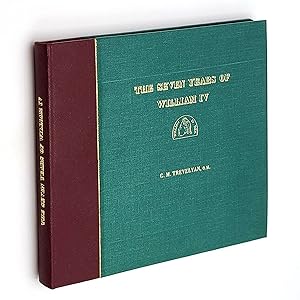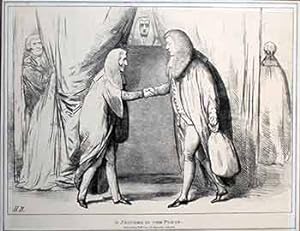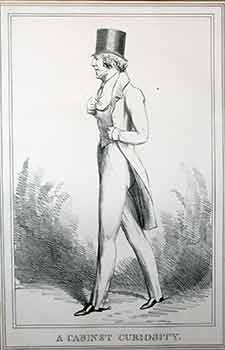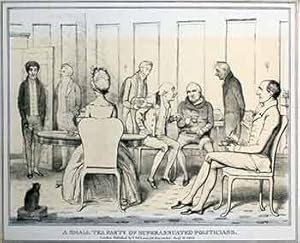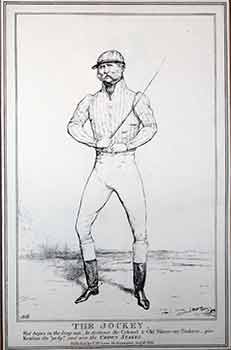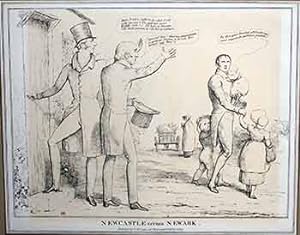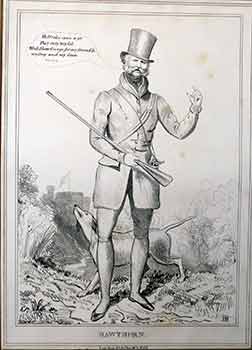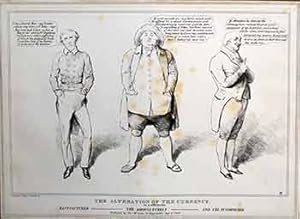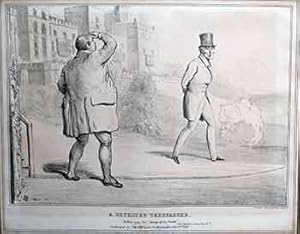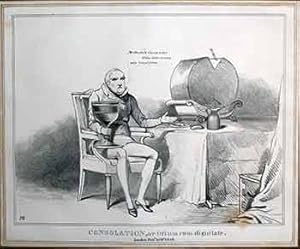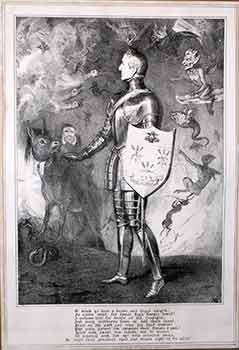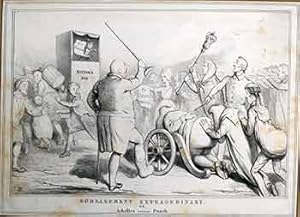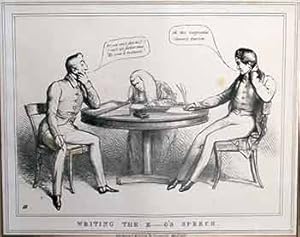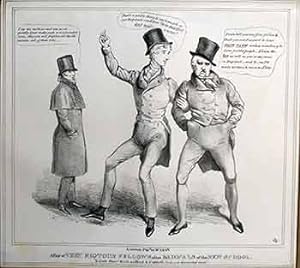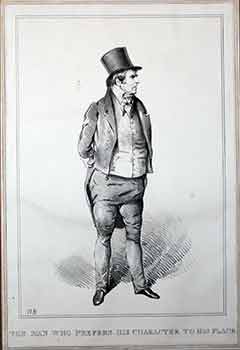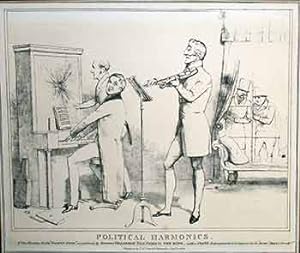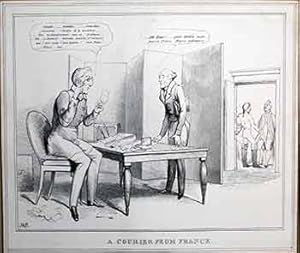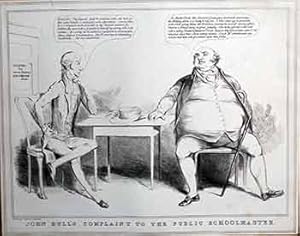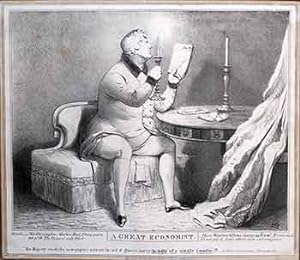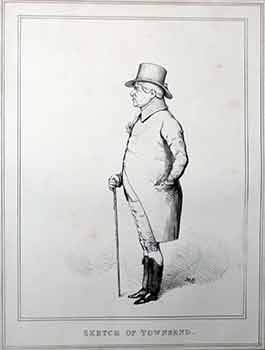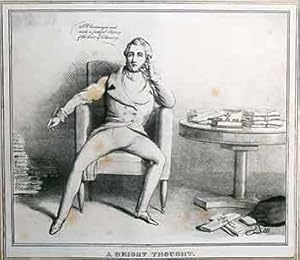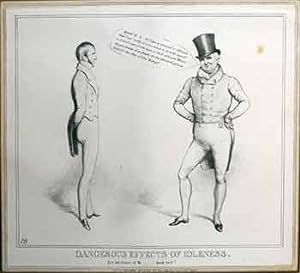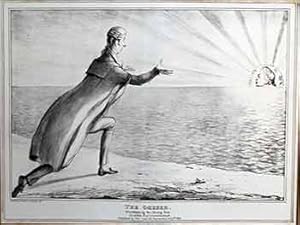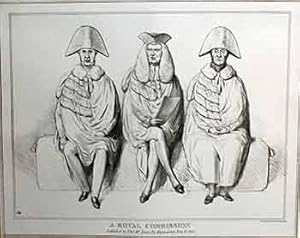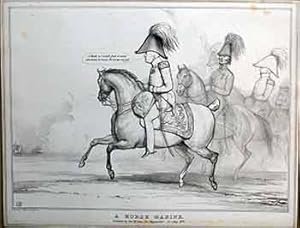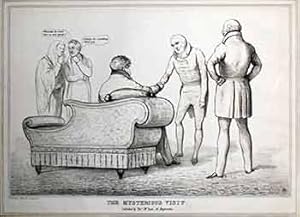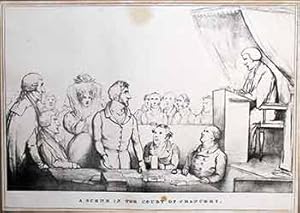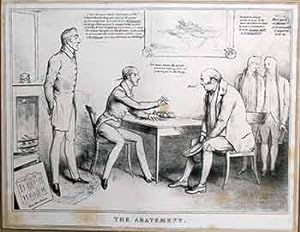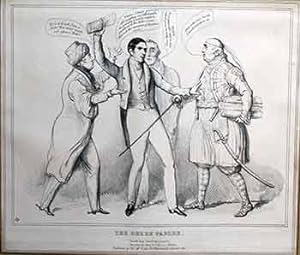john doyle hb, Signiert (85 Ergebnisse)
Produktart
- Alle Product Types
- Bücher (1)
- Magazine & Zeitschriften
- Comics
- Noten
- Kunst, Grafik & Poster (84)
- Fotografien
- Karten
- Manuskripte & Papierantiquitäten
Zustand
Einband
Weitere Eigenschaften
- Erstausgabe
- Signiert
- Schutzumschlag
- Angebotsfoto (67)
- Keine Print-on-Demand Angebote (85)
Gratisversand
- Versand nach USA gratis
Land des Verkäufers
Verkäuferbewertung
-
The Seven Years of William IV: A Reign Cartooned by John Doyle
Verlag: Avalon Press and William Heinemann Ltd, 1952
Buch Signiert
Hardcover. Zustand: Near Fine. Signed and hand numbered, being copy number 104 of this edition of 345 copies signed by the author. Bound in quarter maroon leather with gilt-stamped green cloth sides. Top corner of front free endpaper abraded where price has been erased, else fine. 7 plus [125] pages. 9.5 x 12 inches. 62 full-page cartoons and accompanying notes, sequentially relating to the chief political events in the reign of William IV (1830-1837). The preliminary text and all the notes (including the biographical undernotes) are by G. M. Trevelyan, who also selected the drawings. Signed by Author(s).
-
A Joinder in the Please.
Verlag: London: Thomas MacLean., 1829
Anbieter: Wittenborn Art Books, San Francisco, CA, USA
Kunst / Grafik / Poster Signiert
Zustand: Good. Original lithograph. 13.5 x 10 inches. Very Good. Inserted into light matting.Sitters: James Scarlett, 1st Baron Abinger (1769-1844), Chief Baron of the Exchequer. Henry Brougham, 1st Baron Brougham and Vaux (1778-1868), Lord Chancellor. Edward Burtenshaw Sugden, 1st Baron St Leonards (1781-1875), Lord Chancellor. Sir Nicholas Conyngham Tindal (1776-1846), Chief Justice of Common Pleas. Sir Charles Wetherell (1770-1846), Politician and lawyer.John Doyle (Dublin 1797 ? 2 January 1868 London), known by the pen name H. B., was a political cartoonist, caricaturist, painter and lithographer.In his youth he learned to paint landscapes under Gaspare Gabrielli, and miniature portraits at the Royal Dublin Society's drawing school under John Comerfield. He won a gold medal in 1805. He was commissioned to paint equestrian portraits of the Marquess of Sligo and Lord Talbot, the Irish viceroy, and in 1822 he produced six prints entitled The Life of a Racehorse. That year he moved to London with his wife, Marianna Conan. His painting Turning out the Stag brought him recognition when it was exhibited at the Royal Academy in 1825.Doyle continued to exhibit miniatures until 1835, but by then he was experiencing greater success with his political cartoons, printed using the new reproductive medium of lithography, beginning in 1827. These were issued once a month during parliamentary sessions, and continued for twenty-two years. His caricatures were mostly faithful likenesses of their subjects, with little exaggeration, treated with sarcastic humor, often alluding to popular plays. They were signed with the letters H. B., constructed out of two Js and two Ds, Doyle's own initials. By 1840 he was prosperous enough to afford a fashionable house in Hyde Park, moving in the same circles as David Wilkie, Walter Scott, Samuel Taylor Coleridge, Charles Dickens, William Makepeace Thackeray, Thomas Macaulay, Thomas Moore and Samuel Rogers ? but H. B.'s true identity remained a closely guarded secret until he revealed it in 1843 in a seventeen-page letter to Sir Robert Peel.In the 1840s, at the height of his popularity, indices of H.B.'s prints were published in The Times and by the publisher McLean, but his reputation faded. His later prints were gentle in their humor and drawn in a soft, indistinct style. Thackeray said his cartoons, although clever and witty, were too "genteel" to raise more than a gentlemanly smile ? "You will never hear any laughing at 'H. B.'" When he died in 1868, his obituary in The Art Journal did not appear until three months after his death, and a posthumous sale of his sketches at Christie's in 1882 was canceled for lack of buyers. However, he is considered a founder of the school of British cartoon satirists represented by John Leech, John Tenniel, and his son Richard Doyle, which established the style made famous by Punch magazine. The British Museum has over 900 of his drawings in its collections.
-
A Cabinet Curiosity : Lord Ellenborough.
Verlag: London: Thomas MacLean., 1829
Anbieter: Wittenborn Art Books, San Francisco, CA, USA
Kunst / Grafik / Poster Signiert
Zustand: Good. Original lithograph. 12.5 x 8 inches. Very Good. Inserted into light matting.Sitters: Edward Law, 1st Earl of Ellenborough (1790-1871), Politician, President of the Board of Control and Governor-General of India.John Doyle (Dublin 1797 ? 2 January 1868 London), known by the pen name H. B., was a political cartoonist, caricaturist, painter and lithographer.In his youth he learned to paint landscapes under Gaspare Gabrielli, and miniature portraits at the Royal Dublin Society's drawing school under John Comerfield. He won a gold medal in 1805. He was commissioned to paint equestrian portraits of the Marquess of Sligo and Lord Talbot, the Irish viceroy, and in 1822 he produced six prints entitled The Life of a Racehorse. That year he moved to London with his wife, Marianna Conan. His painting Turning out the Stag brought him recognition when it was exhibited at the Royal Academy in 1825.Doyle continued to exhibit miniatures until 1835, but by then he was experiencing greater success with his political cartoons, printed using the new reproductive medium of lithography, beginning in 1827. These were issued once a month during parliamentary sessions, and continued for twenty-two years. His caricatures were mostly faithful likenesses of their subjects, with little exaggeration, treated with sarcastic humor, often alluding to popular plays. They were signed with the letters H. B., constructed out of two Js and two Ds, Doyle's own initials. By 1840 he was prosperous enough to afford a fashionable house in Hyde Park, moving in the same circles as David Wilkie, Walter Scott, Samuel Taylor Coleridge, Charles Dickens, William Makepeace Thackeray, Thomas Macaulay, Thomas Moore and Samuel Rogers ? but H. B.'s true identity remained a closely guarded secret until he revealed it in 1843 in a seventeen-page letter to Sir Robert Peel.In the 1840s, at the height of his popularity, indices of H.B.'s prints were published in The Times and by the publisher McLean, but his reputation faded. His later prints were gentle in their humor and drawn in a soft, indistinct style. Thackeray said his cartoons, although clever and witty, were too "genteel" to raise more than a gentlemanly smile ? "You will never hear any laughing at 'H. B.'" When he died in 1868, his obituary in The Art Journal did not appear until three months after his death, and a posthumous sale of his sketches at Christie's in 1882 was canceled for lack of buyers. However, he is considered a founder of the school of British cartoon satirists represented by John Leech, John Tenniel, and his son Richard Doyle, which established the style made famous by Punch magazine. The British Museum has over 900 of his drawings in its collections.
-
A Small Tea Party of Superannuated Politicians.
Verlag: London: Thomas MacLean., 1829
Anbieter: Wittenborn Art Books, San Francisco, CA, USA
Kunst / Grafik / Poster Signiert
Zustand: Good. Original lithograph. 13 x 10.5 inches. Very Good. Light toning. Inserted into light matting.Sitters: Nicholas Vansittart, Baron Bexley (1766-1851), Conservative politician; Chancellor of the Exchequer. John Scott, 1st Earl of Eldon (1751-1838), Lord Chancellor. Thomas Manners-Sutton, 1st Baron Manners of Foston (1756-1842), Judge. John Freeman-Mitford, 1st Baron Redesdale (1748-1830), Speaker of the House of Commons. Henry Addington, 1st Viscount Sidmouth (1757-1844), Prime Minister. Sophia Vansittart (died 1836), Sister of Nicholas Vansittart, Baron Bexley.John Doyle (Dublin 1797 ? 2 January 1868 London), known by the pen name H. B., was a political cartoonist, caricaturist, painter and lithographer.In his youth he learned to paint landscapes under Gaspare Gabrielli, and miniature portraits at the Royal Dublin Society's drawing school under John Comerfield. He won a gold medal in 1805. He was commissioned to paint equestrian portraits of the Marquess of Sligo and Lord Talbot, the Irish viceroy, and in 1822 he produced six prints entitled The Life of a Racehorse. That year he moved to London with his wife, Marianna Conan. His painting Turning out the Stag brought him recognition when it was exhibited at the Royal Academy in 1825.Doyle continued to exhibit miniatures until 1835, but by then he was experiencing greater success with his political cartoons, printed using the new reproductive medium of lithography, beginning in 1827. These were issued once a month during parliamentary sessions, and continued for twenty-two years. His caricatures were mostly faithful likenesses of their subjects, with little exaggeration, treated with sarcastic humor, often alluding to popular plays. They were signed with the letters H. B., constructed out of two Js and two Ds, Doyle's own initials. By 1840 he was prosperous enough to afford a fashionable house in Hyde Park, moving in the same circles as David Wilkie, Walter Scott, Samuel Taylor Coleridge, Charles Dickens, William Makepeace Thackeray, Thomas Macaulay, Thomas Moore and Samuel Rogers ? but H. B.'s true identity remained a closely guarded secret until he revealed it in 1843 in a seventeen-page letter to Sir Robert Peel.In the 1840s, at the height of his popularity, indices of H.B.'s prints were published in The Times and by the publisher McLean, but his reputation faded. His later prints were gentle in their humor and drawn in a soft, indistinct style. Thackeray said his cartoons, although clever and witty, were too "genteel" to raise more than a gentlemanly smile ? "You will never hear any laughing at 'H. B.'" When he died in 1868, his obituary in The Art Journal did not appear until three months after his death, and a posthumous sale of his sketches at Christie's in 1882 was canceled for lack of buyers. However, he is considered a founder of the school of British cartoon satirists represented by John Leech, John Tenniel, and his son Richard Doyle, which established the style made famous by Punch magazine. The British Museum has over 900 of his drawings in its collections.
-
The Jockey : Duke of Cumberland.
Verlag: London: Thomas MacLean., 1829
Anbieter: Wittenborn Art Books, San Francisco, CA, USA
Kunst / Grafik / Poster Signiert
Zustand: Good. Original lithograph. 8 x 12.5 inches. Very Good. Inserted into light matting.Sitters: Ernest Augustus, Duke of Cumberland and King of Hanover (1771-1851), Son of George III.John Doyle (Dublin 1797 ? 2 January 1868 London), known by the pen name H. B., was a political cartoonist, caricaturist, painter and lithographer.In his youth he learned to paint landscapes under Gaspare Gabrielli, and miniature portraits at the Royal Dublin Society's drawing school under John Comerfield. He won a gold medal in 1805. He was commissioned to paint equestrian portraits of the Marquess of Sligo and Lord Talbot, the Irish viceroy, and in 1822 he produced six prints entitled The Life of a Racehorse. That year he moved to London with his wife, Marianna Conan. His painting Turning out the Stag brought him recognition when it was exhibited at the Royal Academy in 1825.Doyle continued to exhibit miniatures until 1835, but by then he was experiencing greater success with his political cartoons, printed using the new reproductive medium of lithography, beginning in 1827. These were issued once a month during parliamentary sessions, and continued for twenty-two years. His caricatures were mostly faithful likenesses of their subjects, with little exaggeration, treated with sarcastic humor, often alluding to popular plays. They were signed with the letters H. B., constructed out of two Js and two Ds, Doyle's own initials. By 1840 he was prosperous enough to afford a fashionable house in Hyde Park, moving in the same circles as David Wilkie, Walter Scott, Samuel Taylor Coleridge, Charles Dickens, William Makepeace Thackeray, Thomas Macaulay, Thomas Moore and Samuel Rogers ? but H. B.'s true identity remained a closely guarded secret until he revealed it in 1843 in a seventeen-page letter to Sir Robert Peel.In the 1840s, at the height of his popularity, indices of H.B.'s prints were published in The Times and by the publisher McLean, but his reputation faded. His later prints were gentle in their humor and drawn in a soft, indistinct style. Thackeray said his cartoons, although clever and witty, were too "genteel" to raise more than a gentlemanly smile ? "You will never hear any laughing at 'H. B.'" When he died in 1868, his obituary in The Art Journal did not appear until three months after his death, and a posthumous sale of his sketches at Christie's in 1882 was canceled for lack of buyers. However, he is considered a founder of the school of British cartoon satirists represented by John Leech, John Tenniel, and his son Richard Doyle, which established the style made famous by Punch magazine. The British Museum has over 900 of his drawings in its collections.
-
Newcastle versus Newark (Henry Pelham Pelham-Clinton, 4th Duke of Newcastle-under-Lyne; Michael Thomas Sadler).
Verlag: London: Thomas MacLean., 1829
Anbieter: Wittenborn Art Books, San Francisco, CA, USA
Kunst / Grafik / Poster Signiert
Zustand: Good. Original lithograph. 11 x 13.5 inches. Very Good. Mild toning. Inserted into light matting.Sitters: Henry Pelham Pelham-Clinton, 4th Duke of Newcastle-under-Lyne (1785-1851), Nobleman and politician. Michael Thomas Sadler (1780-1835), Social reformer.John Doyle (Dublin 1797 ? 2 January 1868 London), known by the pen name H. B., was a political cartoonist, caricaturist, painter and lithographer.In his youth he learned to paint landscapes under Gaspare Gabrielli, and miniature portraits at the Royal Dublin Society's drawing school under John Comerfield. He won a gold medal in 1805. He was commissioned to paint equestrian portraits of the Marquess of Sligo and Lord Talbot, the Irish viceroy, and in 1822 he produced six prints entitled The Life of a Racehorse. That year he moved to London with his wife, Marianna Conan. His painting Turning out the Stag brought him recognition when it was exhibited at the Royal Academy in 1825.Doyle continued to exhibit miniatures until 1835, but by then he was experiencing greater success with his political cartoons, printed using the new reproductive medium of lithography, beginning in 1827. These were issued once a month during parliamentary sessions, and continued for twenty-two years. His caricatures were mostly faithful likenesses of their subjects, with little exaggeration, treated with sarcastic humor, often alluding to popular plays. They were signed with the letters H. B., constructed out of two Js and two Ds, Doyle's own initials. By 1840 he was prosperous enough to afford a fashionable house in Hyde Park, moving in the same circles as David Wilkie, Walter Scott, Samuel Taylor Coleridge, Charles Dickens, William Makepeace Thackeray, Thomas Macaulay, Thomas Moore and Samuel Rogers ? but H. B.'s true identity remained a closely guarded secret until he revealed it in 1843 in a seventeen-page letter to Sir Robert Peel.In the 1840s, at the height of his popularity, indices of H.B.'s prints were published in The Times and by the publisher McLean, but his reputation faded. His later prints were gentle in their humor and drawn in a soft, indistinct style. Thackeray said his cartoons, although clever and witty, were too "genteel" to raise more than a gentlemanly smile ? "You will never hear any laughing at 'H. B.'" When he died in 1868, his obituary in The Art Journal did not appear until three months after his death, and a posthumous sale of his sketches at Christie's in 1882 was canceled for lack of buyers. However, he is considered a founder of the school of British cartoon satirists represented by John Leech, John Tenniel, and his son Richard Doyle, which established the style made famous by Punch magazine. The British Museum has over 900 of his drawings in its collections.
-
Hawthorn (Ernest Augustus, Duke of Cumberland and King of Hanover).
Verlag: London: Thomas MacLean., 1830
Anbieter: Wittenborn Art Books, San Francisco, CA, USA
Kunst / Grafik / Poster Signiert
Zustand: Good. Original lithograph. 10 x 13.5 inches. Very Good. Light spots of foxing. Inserted into light matting.Sitter: Ernest Augustus, Duke of Cumberland and King of Hanover (1771-1851), Son of George III.John Doyle (Dublin 1797 ? 2 January 1868 London), known by the pen name H. B., was a political cartoonist, caricaturist, painter and lithographer.In his youth he learned to paint landscapes under Gaspare Gabrielli, and miniature portraits at the Royal Dublin Society's drawing school under John Comerfield. He won a gold medal in 1805. He was commissioned to paint equestrian portraits of the Marquess of Sligo and Lord Talbot, the Irish viceroy, and in 1822 he produced six prints entitled The Life of a Racehorse. That year he moved to London with his wife, Marianna Conan. His painting Turning out the Stag brought him recognition when it was exhibited at the Royal Academy in 1825.Doyle continued to exhibit miniatures until 1835, but by then he was experiencing greater success with his political cartoons, printed using the new reproductive medium of lithography, beginning in 1827. These were issued once a month during parliamentary sessions, and continued for twenty-two years. His caricatures were mostly faithful likenesses of their subjects, with little exaggeration, treated with sarcastic humor, often alluding to popular plays. They were signed with the letters H. B., constructed out of two Js and two Ds, Doyle's own initials. By 1840 he was prosperous enough to afford a fashionable house in Hyde Park, moving in the same circles as David Wilkie, Walter Scott, Samuel Taylor Coleridge, Charles Dickens, William Makepeace Thackeray, Thomas Macaulay, Thomas Moore and Samuel Rogers ? but H. B.'s true identity remained a closely guarded secret until he revealed it in 1843 in a seventeen-page letter to Sir Robert Peel.In the 1840s, at the height of his popularity, indices of H.B.'s prints were published in The Times and by the publisher McLean, but his reputation faded. His later prints were gentle in their humor and drawn in a soft, indistinct style. Thackeray said his cartoons, although clever and witty, were too "genteel" to raise more than a gentlemanly smile ? "You will never hear any laughing at 'H. B.'" When he died in 1868, his obituary in The Art Journal did not appear until three months after his death, and a posthumous sale of his sketches at Christie's in 1882 was canceled for lack of buyers. However, he is considered a founder of the school of British cartoon satirists represented by John Leech, John Tenniel, and his son Richard Doyle, which established the style made famous by Punch magazine. The British Museum has over 900 of his drawings in its collections.
-
The Alteration of the Currency (includes John Bull).
Verlag: London: Thomas MacLean., 1830
Anbieter: Wittenborn Art Books, San Francisco, CA, USA
Kunst / Grafik / Poster Signiert
Zustand: Good. Original lithograph. 10.5 x 15 inches. Very Good. Light spots of foxing. Inserted into light matting. Published 3 August, 1830.John Doyle (Dublin 1797 ? 2 January 1868 London), known by the pen name H. B., was a political cartoonist, caricaturist, painter and lithographer.In his youth he learned to paint landscapes under Gaspare Gabrielli, and miniature portraits at the Royal Dublin Society's drawing school under John Comerfield. He won a gold medal in 1805. He was commissioned to paint equestrian portraits of the Marquess of Sligo and Lord Talbot, the Irish viceroy, and in 1822 he produced six prints entitled The Life of a Racehorse. That year he moved to London with his wife, Marianna Conan. His painting Turning out the Stag brought him recognition when it was exhibited at the Royal Academy in 1825.Doyle continued to exhibit miniatures until 1835, but by then he was experiencing greater success with his political cartoons, printed using the new reproductive medium of lithography, beginning in 1827. These were issued once a month during parliamentary sessions, and continued for twenty-two years. His caricatures were mostly faithful likenesses of their subjects, with little exaggeration, treated with sarcastic humor, often alluding to popular plays. They were signed with the letters H. B., constructed out of two Js and two Ds, Doyle's own initials. By 1840 he was prosperous enough to afford a fashionable house in Hyde Park, moving in the same circles as David Wilkie, Walter Scott, Samuel Taylor Coleridge, Charles Dickens, William Makepeace Thackeray, Thomas Macaulay, Thomas Moore and Samuel Rogers ? but H. B.'s true identity remained a closely guarded secret until he revealed it in 1843 in a seventeen-page letter to Sir Robert Peel.In the 1840s, at the height of his popularity, indices of H.B.'s prints were published in The Times and by the publisher McLean, but his reputation faded. His later prints were gentle in their humor and drawn in a soft, indistinct style. Thackeray said his cartoons, although clever and witty, were too "genteel" to raise more than a gentlemanly smile ? "You will never hear any laughing at 'H. B.'" When he died in 1868, his obituary in The Art Journal did not appear until three months after his death, and a posthumous sale of his sketches at Christie's in 1882 was canceled for lack of buyers. However, he is considered a founder of the school of British cartoon satirists represented by John Leech, John Tenniel, and his son Richard Doyle, which established the style made famous by Punch magazine. The British Museum has over 900 of his drawings in its collections.
-
A Detected Trespasser (Arthur Wellesley, 1st Duke of Wellington).
Verlag: London: Thomas MacLean., 1830
Anbieter: Wittenborn Art Books, San Francisco, CA, USA
Kunst / Grafik / Poster Signiert
Zustand: Good. Original lithograph. 14.5 x 11.5 inches. Very Good. Light, partial toning. Inserted into light matting. Published 22 July, 1830.Sitters: Arthur Wellesley, 1st Duke of Wellington (1769-1852), Field Marshal and Prime Minister. John Doyle (Dublin 1797 ? 2 January 1868 London), known by the pen name H. B., was a political cartoonist, caricaturist, painter and lithographer.In his youth he learned to paint landscapes under Gaspare Gabrielli, and miniature portraits at the Royal Dublin Society's drawing school under John Comerfield. He won a gold medal in 1805. He was commissioned to paint equestrian portraits of the Marquess of Sligo and Lord Talbot, the Irish viceroy, and in 1822 he produced six prints entitled The Life of a Racehorse. That year he moved to London with his wife, Marianna Conan. His painting Turning out the Stag brought him recognition when it was exhibited at the Royal Academy in 1825.Doyle continued to exhibit miniatures until 1835, but by then he was experiencing greater success with his political cartoons, printed using the new reproductive medium of lithography, beginning in 1827. These were issued once a month during parliamentary sessions, and continued for twenty-two years. His caricatures were mostly faithful likenesses of their subjects, with little exaggeration, treated with sarcastic humor, often alluding to popular plays. They were signed with the letters H. B., constructed out of two Js and two Ds, Doyle's own initials. By 1840 he was prosperous enough to afford a fashionable house in Hyde Park, moving in the same circles as David Wilkie, Walter Scott, Samuel Taylor Coleridge, Charles Dickens, William Makepeace Thackeray, Thomas Macaulay, Thomas Moore and Samuel Rogers ? but H. B.'s true identity remained a closely guarded secret until he revealed it in 1843 in a seventeen-page letter to Sir Robert Peel.In the 1840s, at the height of his popularity, indices of H.B.'s prints were published in The Times and by the publisher McLean, but his reputation faded. His later prints were gentle in their humor and drawn in a soft, indistinct style. Thackeray said his cartoons, although clever and witty, were too "genteel" to raise more than a gentlemanly smile ? "You will never hear any laughing at 'H. B.'" When he died in 1868, his obituary in The Art Journal did not appear until three months after his death, and a posthumous sale of his sketches at Christie's in 1882 was canceled for lack of buyers. However, he is considered a founder of the school of British cartoon satirists represented by John Leech, John Tenniel, and his son Richard Doyle, which established the style made famous by Punch magazine. The British Museum has over 900 of his drawings in its collections.
-
Consolation, or Otium cum dignitate (John Scott, 1st Earl of Eldon).
Verlag: London: Thomas MacLean., 1829
Anbieter: Wittenborn Art Books, San Francisco, CA, USA
Kunst / Grafik / Poster Signiert
Zustand: Good. Original lithograph. 10.5 x 13 inches. Very Good. Light signs of foxing. Inserted into light matting.John Doyle (Dublin 1797 ? 2 January 1868 London), known by the pen name H. B., was a political cartoonist, caricaturist, painter and lithographer.In his youth he learned to paint landscapes under Gaspare Gabrielli, and miniature portraits at the Royal Dublin Society's drawing school under John Comerfield. He won a gold medal in 1805. He was commissioned to paint equestrian portraits of the Marquess of Sligo and Lord Talbot, the Irish viceroy, and in 1822 he produced six prints entitled The Life of a Racehorse. That year he moved to London with his wife, Marianna Conan. His painting Turning out the Stag brought him recognition when it was exhibited at the Royal Academy in 1825.Doyle continued to exhibit miniatures until 1835, but by then he was experiencing greater success with his political cartoons, printed using the new reproductive medium of lithography, beginning in 1827. These were issued once a month during parliamentary sessions, and continued for twenty-two years. His caricatures were mostly faithful likenesses of their subjects, with little exaggeration, treated with sarcastic humor, often alluding to popular plays. They were signed with the letters H. B., constructed out of two Js and two Ds, Doyle's own initials. By 1840 he was prosperous enough to afford a fashionable house in Hyde Park, moving in the same circles as David Wilkie, Walter Scott, Samuel Taylor Coleridge, Charles Dickens, William Makepeace Thackeray, Thomas Macaulay, Thomas Moore and Samuel Rogers ? but H. B.'s true identity remained a closely guarded secret until he revealed it in 1843 in a seventeen-page letter to Sir Robert Peel.In the 1840s, at the height of his popularity, indices of H.B.'s prints were published in The Times and by the publisher McLean, but his reputation faded. His later prints were gentle in their humor and drawn in a soft, indistinct style. Thackeray said his cartoons, although clever and witty, were too "genteel" to raise more than a gentlemanly smile ? "You will never hear any laughing at 'H. B.'" When he died in 1868, his obituary in The Art Journal did not appear until three months after his death, and a posthumous sale of his sketches at Christie's in 1882 was canceled for lack of buyers. However, he is considered a founder of the school of British cartoon satirists represented by John Leech, John Tenniel, and his son Richard Doyle, which established the style made famous by Punch magazine. The British Museum has over 900 of his drawings in its collections.
-
Sir R. Peel as a Knight.
Verlag: London: Thomas MacLean., 1830
Anbieter: Wittenborn Art Books, San Francisco, CA, USA
Kunst / Grafik / Poster Signiert
Zustand: Good. Original lithograph. 10 x 14.5 inches. Very Good. Inserted into light matting.John Doyle (Dublin 1797 ? 2 January 1868 London), known by the pen name H. B., was a political cartoonist, caricaturist, painter and lithographer.In his youth he learned to paint landscapes under Gaspare Gabrielli, and miniature portraits at the Royal Dublin Society's drawing school under John Comerfield. He won a gold medal in 1805. He was commissioned to paint equestrian portraits of the Marquess of Sligo and Lord Talbot, the Irish viceroy, and in 1822 he produced six prints entitled The Life of a Racehorse. That year he moved to London with his wife, Marianna Conan. His painting Turning out the Stag brought him recognition when it was exhibited at the Royal Academy in 1825.Doyle continued to exhibit miniatures until 1835, but by then he was experiencing greater success with his political cartoons, printed using the new reproductive medium of lithography, beginning in 1827. These were issued once a month during parliamentary sessions, and continued for twenty-two years. His caricatures were mostly faithful likenesses of their subjects, with little exaggeration, treated with sarcastic humor, often alluding to popular plays. They were signed with the letters H. B., constructed out of two Js and two Ds, Doyle's own initials. By 1840 he was prosperous enough to afford a fashionable house in Hyde Park, moving in the same circles as David Wilkie, Walter Scott, Samuel Taylor Coleridge, Charles Dickens, William Makepeace Thackeray, Thomas Macaulay, Thomas Moore and Samuel Rogers ? but H. B.'s true identity remained a closely guarded secret until he revealed it in 1843 in a seventeen-page letter to Sir Robert Peel.In the 1840s, at the height of his popularity, indices of H.B.'s prints were published in The Times and by the publisher McLean, but his reputation faded. His later prints were gentle in their humor and drawn in a soft, indistinct style. Thackeray said his cartoons, although clever and witty, were too "genteel" to raise more than a gentlemanly smile ? "You will never hear any laughing at 'H. B.'" When he died in 1868, his obituary in The Art Journal did not appear until three months after his death, and a posthumous sale of his sketches at Christie's in 1882 was canceled for lack of buyers. However, he is considered a founder of the school of British cartoon satirists represented by John Leech, John Tenniel, and his son Richard Doyle, which established the style made famous by Punch magazine. The British Museum has over 900 of his drawings in its collections.
-
Bombardment Extraordinary, or Achilles versus Punch.
Verlag: London: Thomas MacLean., 1830
Anbieter: Wittenborn Art Books, San Francisco, CA, USA
Kunst / Grafik / Poster Signiert
Zustand: Good. Original lithograph. 12 x 16 inches. Very Good. Light foxing. Inserted into light matting.Sitters: James Scarlett, 1st Baron Abinger (1769-1844), Chief Baron of the Exchequer. Sitter associated with 39 portraits. IdentifyRobert Alexander (1795-1854), Editor and newspaper proprietor. Henry Brougham, 1st Baron Brougham and Vaux (1778-1868), Lord Chancellor. John Scott, 1st Earl of Eldon (1751-1838), Lord Chancellor. Ernest Augustus, Duke of Cumberland and King of Hanover (1771-1851), Son of George III. Henry Richard Fox (later Vassall), 3rd Baron Holland (1773-1840), Whig statesman and patron of art and letters. John Singleton Copley, Baron Lyndhurst (1772-1863), Lord Chancellor and politician; son of the painter John Singleton Copley. Sir Robert Peel, 2nd Bt (1788-1850), Prime Minister. Edward Burtenshaw Sugden, 1st Baron St Leonards (1781-1875), Lord Chancellor. Arthur Wellesley, 1st Duke of Wellington (1769-1852), Field Marshal and Prime Minister.John Doyle (Dublin 1797 ? 2 January 1868 London), known by the pen name H. B., was a political cartoonist, caricaturist, painter and lithographer.In his youth he learned to paint landscapes under Gaspare Gabrielli, and miniature portraits at the Royal Dublin Society's drawing school under John Comerfield. He won a gold medal in 1805. He was commissioned to paint equestrian portraits of the Marquess of Sligo and Lord Talbot, the Irish viceroy, and in 1822 he produced six prints entitled The Life of a Racehorse. That year he moved to London with his wife, Marianna Conan. His painting Turning out the Stag brought him recognition when it was exhibited at the Royal Academy in 1825.Doyle continued to exhibit miniatures until 1835, but by then he was experiencing greater success with his political cartoons, printed using the new reproductive medium of lithography, beginning in 1827. These were issued once a month during parliamentary sessions, and continued for twenty-two years. His caricatures were mostly faithful likenesses of their subjects, with little exaggeration, treated with sarcastic humor, often alluding to popular plays. They were signed with the letters H. B., constructed out of two Js and two Ds, Doyle's own initials. By 1840 he was prosperous enough to afford a fashionable house in Hyde Park, moving in the same circles as David Wilkie, Walter Scott, Samuel Taylor Coleridge, Charles Dickens, William Makepeace Thackeray, Thomas Macaulay, Thomas Moore and Samuel Rogers ? but H. B.'s true identity remained a closely guarded secret until he revealed it in 1843 in a seventeen-page letter to Sir Robert Peel.In the 1840s, at the height of his popularity, indices of H.B.'s prints were published in The Times and by the publisher McLean, but his reputation faded. His later prints were gentle in their humor and drawn in a soft, indistinct style. Thackeray said his cartoons, although clever and witty, were too "genteel" to raise more than a gentlemanly smile ? "You will never hear any laughing at 'H. B.'" When he died in 1868, his obituary in The Art Journal did not appear until three months after his death, and a posthumous sale of his sketches at Christie's in 1882 was canceled for lack of buyers. However, he is considered a founder of the school of British cartoon satirists represented by John Leech, John Tenniel, and his son Richard Doyle, which established the style made famous by Punch magazine. The British Museum has over 900 of his drawings in its collections.
-
Writing the K-g's Speech (Arthur Wellesley, John Singleton Copley, Baron Lyndhurst; 1st Duke of Wellington; Sir Robert Peel, 2nd Bt).
Verlag: London: Thomas MacLean., 1830
Anbieter: Wittenborn Art Books, San Francisco, CA, USA
Kunst / Grafik / Poster Signiert
Zustand: Good. Original lithograph. 10 x 12.5 inches. Very Good. Minor spots of foxing. Inserted into light matting. Published 1 February 1830.Sitters: John Singleton Copley, Baron Lyndhurst (1772-1863), Lord Chancellor and politician; son of the painter John Singleton Copley. Sir Robert Peel, 2nd Bt (1788-1850), Prime Minister. Arthur Wellesley, 1st Duke of Wellington (1769-1852), Field Marshal and Prime Minister.John Doyle (Dublin 1797 ? 2 January 1868 London), known by the pen name H. B., was a political cartoonist, caricaturist, painter and lithographer.In his youth he learned to paint landscapes under Gaspare Gabrielli, and miniature portraits at the Royal Dublin Society's drawing school under John Comerfield. He won a gold medal in 1805. He was commissioned to paint equestrian portraits of the Marquess of Sligo and Lord Talbot, the Irish viceroy, and in 1822 he produced six prints entitled The Life of a Racehorse. That year he moved to London with his wife, Marianna Conan. His painting Turning out the Stag brought him recognition when it was exhibited at the Royal Academy in 1825.Doyle continued to exhibit miniatures until 1835, but by then he was experiencing greater success with his political cartoons, printed using the new reproductive medium of lithography, beginning in 1827. These were issued once a month during parliamentary sessions, and continued for twenty-two years. His caricatures were mostly faithful likenesses of their subjects, with little exaggeration, treated with sarcastic humor, often alluding to popular plays. They were signed with the letters H. B., constructed out of two Js and two Ds, Doyle's own initials. By 1840 he was prosperous enough to afford a fashionable house in Hyde Park, moving in the same circles as David Wilkie, Walter Scott, Samuel Taylor Coleridge, Charles Dickens, William Makepeace Thackeray, Thomas Macaulay, Thomas Moore and Samuel Rogers ? but H. B.'s true identity remained a closely guarded secret until he revealed it in 1843 in a seventeen-page letter to Sir Robert Peel.In the 1840s, at the height of his popularity, indices of H.B.'s prints were published in The Times and by the publisher McLean, but his reputation faded. His later prints were gentle in their humor and drawn in a soft, indistinct style. Thackeray said his cartoons, although clever and witty, were too "genteel" to raise more than a gentlemanly smile ? "You will never hear any laughing at 'H. B.'" When he died in 1868, his obituary in The Art Journal did not appear until three months after his death, and a posthumous sale of his sketches at Christie's in 1882 was canceled for lack of buyers. However, he is considered a founder of the school of British cartoon satirists represented by John Leech, John Tenniel, and his son Richard Doyle, which established the style made famous by Punch magazine. The British Museum has over 900 of his drawings in its collections.
-
A Pair of Very Riotous Fellows alias Radicals of the New School.
Verlag: London: Thomas MacLean., 1830
Anbieter: Wittenborn Art Books, San Francisco, CA, USA
Kunst / Grafik / Poster Signiert
Zustand: Good. Original lithograph. 12.5 x 11.5 inches. Very Good. Inserted into light matting. Published March, 1830.Sitters: John Scott, 1st Earl of Eldon (1751-1838), Lord Chancellor. Charles Stanhope, 4th Earl of Harrington (1780-1851), Dandy, colonel and Lord of the Bedchamber. Arthur Wellesley, 1st Duke of Wellington (1769-1852), Field Marshal and Prime Minister.John Doyle (Dublin 1797 ? 2 January 1868 London), known by the pen name H. B., was a political cartoonist, caricaturist, painter and lithographer.In his youth he learned to paint landscapes under Gaspare Gabrielli, and miniature portraits at the Royal Dublin Society's drawing school under John Comerfield. He won a gold medal in 1805. He was commissioned to paint equestrian portraits of the Marquess of Sligo and Lord Talbot, the Irish viceroy, and in 1822 he produced six prints entitled The Life of a Racehorse. That year he moved to London with his wife, Marianna Conan. His painting Turning out the Stag brought him recognition when it was exhibited at the Royal Academy in 1825.Doyle continued to exhibit miniatures until 1835, but by then he was experiencing greater success with his political cartoons, printed using the new reproductive medium of lithography, beginning in 1827. These were issued once a month during parliamentary sessions, and continued for twenty-two years. His caricatures were mostly faithful likenesses of their subjects, with little exaggeration, treated with sarcastic humor, often alluding to popular plays. They were signed with the letters H. B., constructed out of two Js and two Ds, Doyle's own initials. By 1840 he was prosperous enough to afford a fashionable house in Hyde Park, moving in the same circles as David Wilkie, Walter Scott, Samuel Taylor Coleridge, Charles Dickens, William Makepeace Thackeray, Thomas Macaulay, Thomas Moore and Samuel Rogers ? but H. B.'s true identity remained a closely guarded secret until he revealed it in 1843 in a seventeen-page letter to Sir Robert Peel.In the 1840s, at the height of his popularity, indices of H.B.'s prints were published in The Times and by the publisher McLean, but his reputation faded. His later prints were gentle in their humor and drawn in a soft, indistinct style. Thackeray said his cartoons, although clever and witty, were too "genteel" to raise more than a gentlemanly smile ? "You will never hear any laughing at 'H. B.'" When he died in 1868, his obituary in The Art Journal did not appear until three months after his death, and a posthumous sale of his sketches at Christie's in 1882 was canceled for lack of buyers. However, he is considered a founder of the school of British cartoon satirists represented by John Leech, John Tenniel, and his son Richard Doyle, which established the style made famous by Punch magazine. The British Museum has over 900 of his drawings in its collections.
-
Sir Charles Wetherell : The Man who Prefers his Character to his Place.
Verlag: London: Thomas MacLean., 1829
Anbieter: Wittenborn Art Books, San Francisco, CA, USA
Kunst / Grafik / Poster Signiert
Zustand: Good. Original lithograph. 13.5 x 9 inches. Very Good. Inserted into light matting.Sitters: Sir Charles Wetherell (1770-1846), Politician and lawyer.John Doyle (Dublin 1797 ? 2 January 1868 London), known by the pen name H. B., was a political cartoonist, caricaturist, painter and lithographer.In his youth he learned to paint landscapes under Gaspare Gabrielli, and miniature portraits at the Royal Dublin Society's drawing school under John Comerfield. He won a gold medal in 1805. He was commissioned to paint equestrian portraits of the Marquess of Sligo and Lord Talbot, the Irish viceroy, and in 1822 he produced six prints entitled The Life of a Racehorse. That year he moved to London with his wife, Marianna Conan. His painting Turning out the Stag brought him recognition when it was exhibited at the Royal Academy in 1825.Doyle continued to exhibit miniatures until 1835, but by then he was experiencing greater success with his political cartoons, printed using the new reproductive medium of lithography, beginning in 1827. These were issued once a month during parliamentary sessions, and continued for twenty-two years. His caricatures were mostly faithful likenesses of their subjects, with little exaggeration, treated with sarcastic humor, often alluding to popular plays. They were signed with the letters H. B., constructed out of two Js and two Ds, Doyle's own initials. By 1840 he was prosperous enough to afford a fashionable house in Hyde Park, moving in the same circles as David Wilkie, Walter Scott, Samuel Taylor Coleridge, Charles Dickens, William Makepeace Thackeray, Thomas Macaulay, Thomas Moore and Samuel Rogers ? but H. B.'s true identity remained a closely guarded secret until he revealed it in 1843 in a seventeen-page letter to Sir Robert Peel.In the 1840s, at the height of his popularity, indices of H.B.'s prints were published in The Times and by the publisher McLean, but his reputation faded. His later prints were gentle in their humor and drawn in a soft, indistinct style. Thackeray said his cartoons, although clever and witty, were too "genteel" to raise more than a gentlemanly smile ? "You will never hear any laughing at 'H. B.'" When he died in 1868, his obituary in The Art Journal did not appear until three months after his death, and a posthumous sale of his sketches at Christie's in 1882 was canceled for lack of buyers. However, he is considered a founder of the school of British cartoon satirists represented by John Leech, John Tenniel, and his son Richard Doyle, which established the style made famous by Punch magazine. The British Museum has over 900 of his drawings in its collections.
-
Political Harmonics.
Verlag: London: Thomas MacLean., 1829
Anbieter: Wittenborn Art Books, San Francisco, CA, USA
Kunst / Grafik / Poster Signiert
Zustand: Good. Original lithograph. 13.5 x 11 inches. Very Good. Minor chip on bottom edge. Inserted into light matting.Sitters: John Scott, 1st Earl of Eldon (1751-1838), Lord Chancellor. Ernest Augustus, Duke of Cumberland and King of Hanover (1771-1851), Son of George III. Henry Goulburn (1784-1856), Conservative politician; MP for Cambridge University. Sir Robert Peel, 2nd Bt (1788-1850), Prime Minister. Arthur Wellesley, 1st Duke of Wellington (1769-1852), Field Marshal and Prime Minister.John Doyle (Dublin 1797 ? 2 January 1868 London), known by the pen name H. B., was a political cartoonist, caricaturist, painter and lithographer.In his youth he learned to paint landscapes under Gaspare Gabrielli, and miniature portraits at the Royal Dublin Society's drawing school under John Comerfield. He won a gold medal in 1805. He was commissioned to paint equestrian portraits of the Marquess of Sligo and Lord Talbot, the Irish viceroy, and in 1822 he produced six prints entitled The Life of a Racehorse. That year he moved to London with his wife, Marianna Conan. His painting Turning out the Stag brought him recognition when it was exhibited at the Royal Academy in 1825.Doyle continued to exhibit miniatures until 1835, but by then he was experiencing greater success with his political cartoons, printed using the new reproductive medium of lithography, beginning in 1827. These were issued once a month during parliamentary sessions, and continued for twenty-two years. His caricatures were mostly faithful likenesses of their subjects, with little exaggeration, treated with sarcastic humor, often alluding to popular plays. They were signed with the letters H. B., constructed out of two Js and two Ds, Doyle's own initials. By 1840 he was prosperous enough to afford a fashionable house in Hyde Park, moving in the same circles as David Wilkie, Walter Scott, Samuel Taylor Coleridge, Charles Dickens, William Makepeace Thackeray, Thomas Macaulay, Thomas Moore and Samuel Rogers ? but H. B.'s true identity remained a closely guarded secret until he revealed it in 1843 in a seventeen-page letter to Sir Robert Peel.In the 1840s, at the height of his popularity, indices of H.B.'s prints were published in The Times and by the publisher McLean, but his reputation faded. His later prints were gentle in their humor and drawn in a soft, indistinct style. Thackeray said his cartoons, although clever and witty, were too "genteel" to raise more than a gentlemanly smile ? "You will never hear any laughing at 'H. B.'" When he died in 1868, his obituary in The Art Journal did not appear until three months after his death, and a posthumous sale of his sketches at Christie's in 1882 was canceled for lack of buyers. However, he is considered a founder of the school of British cartoon satirists represented by John Leech, John Tenniel, and his son Richard Doyle, which established the style made famous by Punch magazine. The British Museum has over 900 of his drawings in its collections.
-
Political Harmonics.
Verlag: London: Thomas MacLean., 1829
Anbieter: Wittenborn Art Books, San Francisco, CA, USA
Kunst / Grafik / Poster Signiert
Zustand: Good. Original lithograph. 13.5 x 11 inches. Very Good. Minor chip on bottom edge. Inserted into light matting.Sitters: John Scott, 1st Earl of Eldon (1751-1838), Lord Chancellor. Ernest Augustus, Duke of Cumberland and King of Hanover (1771-1851), Son of George III. Henry Goulburn (1784-1856), Conservative politician; MP for Cambridge University. Sir Robert Peel, 2nd Bt (1788-1850), Prime Minister. Arthur Wellesley, 1st Duke of Wellington (1769-1852), Field Marshal and Prime Minister.John Doyle (Dublin 1797 ? 2 January 1868 London), known by the pen name H. B., was a political cartoonist, caricaturist, painter and lithographer.In his youth he learned to paint landscapes under Gaspare Gabrielli, and miniature portraits at the Royal Dublin Society's drawing school under John Comerfield. He won a gold medal in 1805. He was commissioned to paint equestrian portraits of the Marquess of Sligo and Lord Talbot, the Irish viceroy, and in 1822 he produced six prints entitled The Life of a Racehorse. That year he moved to London with his wife, Marianna Conan. His painting Turning out the Stag brought him recognition when it was exhibited at the Royal Academy in 1825.Doyle continued to exhibit miniatures until 1835, but by then he was experiencing greater success with his political cartoons, printed using the new reproductive medium of lithography, beginning in 1827. These were issued once a month during parliamentary sessions, and continued for twenty-two years. His caricatures were mostly faithful likenesses of their subjects, with little exaggeration, treated with sarcastic humor, often alluding to popular plays. They were signed with the letters H. B., constructed out of two Js and two Ds, Doyle's own initials. By 1840 he was prosperous enough to afford a fashionable house in Hyde Park, moving in the same circles as David Wilkie, Walter Scott, Samuel Taylor Coleridge, Charles Dickens, William Makepeace Thackeray, Thomas Macaulay, Thomas Moore and Samuel Rogers ? but H. B.'s true identity remained a closely guarded secret until he revealed it in 1843 in a seventeen-page letter to Sir Robert Peel.In the 1840s, at the height of his popularity, indices of H.B.'s prints were published in The Times and by the publisher McLean, but his reputation faded. His later prints were gentle in their humor and drawn in a soft, indistinct style. Thackeray said his cartoons, although clever and witty, were too "genteel" to raise more than a gentlemanly smile ? "You will never hear any laughing at 'H. B.'" When he died in 1868, his obituary in The Art Journal did not appear until three months after his death, and a posthumous sale of his sketches at Christie's in 1882 was canceled for lack of buyers. However, he is considered a founder of the school of British cartoon satirists represented by John Leech, John Tenniel, and his son Richard Doyle, which established the style made famous by Punch magazine. The British Museum has over 900 of his drawings in its collections.
-
A Courier from France (Arthur Wellesley, 1st Duke of Wellington).
Verlag: London: Thomas MacLean., 1829
Anbieter: Wittenborn Art Books, San Francisco, CA, USA
Kunst / Grafik / Poster Signiert
Zustand: Good. Original lithograph. 10 x 12 inches. Very Good. Inserted into light matting.Sitters: Arthur Wellesley, 1st Duke of Wellington (1769-1852), Field Marshal and Prime Minister.John Doyle (Dublin 1797 ? 2 January 1868 London), known by the pen name H. B., was a political cartoonist, caricaturist, painter and lithographer.In his youth he learned to paint landscapes under Gaspare Gabrielli, and miniature portraits at the Royal Dublin Society's drawing school under John Comerfield. He won a gold medal in 1805. He was commissioned to paint equestrian portraits of the Marquess of Sligo and Lord Talbot, the Irish viceroy, and in 1822 he produced six prints entitled The Life of a Racehorse. That year he moved to London with his wife, Marianna Conan. His painting Turning out the Stag brought him recognition when it was exhibited at the Royal Academy in 1825.Doyle continued to exhibit miniatures until 1835, but by then he was experiencing greater success with his political cartoons, printed using the new reproductive medium of lithography, beginning in 1827. These were issued once a month during parliamentary sessions, and continued for twenty-two years. His caricatures were mostly faithful likenesses of their subjects, with little exaggeration, treated with sarcastic humor, often alluding to popular plays. They were signed with the letters H. B., constructed out of two Js and two Ds, Doyle's own initials. By 1840 he was prosperous enough to afford a fashionable house in Hyde Park, moving in the same circles as David Wilkie, Walter Scott, Samuel Taylor Coleridge, Charles Dickens, William Makepeace Thackeray, Thomas Macaulay, Thomas Moore and Samuel Rogers ? but H. B.'s true identity remained a closely guarded secret until he revealed it in 1843 in a seventeen-page letter to Sir Robert Peel.In the 1840s, at the height of his popularity, indices of H.B.'s prints were published in The Times and by the publisher McLean, but his reputation faded. His later prints were gentle in their humor and drawn in a soft, indistinct style. Thackeray said his cartoons, although clever and witty, were too "genteel" to raise more than a gentlemanly smile ? "You will never hear any laughing at 'H. B.'" When he died in 1868, his obituary in The Art Journal did not appear until three months after his death, and a posthumous sale of his sketches at Christie's in 1882 was canceled for lack of buyers. However, he is considered a founder of the school of British cartoon satirists represented by John Leech, John Tenniel, and his son Richard Doyle, which established the style made famous by Punch magazine. The British Museum has over 900 of his drawings in its collections.
-
John Bull's Complaint to the Public Schoolmaster (Henry Brougham, 1st Baron Brougham and Vaux; John Bull).
Verlag: London: Thomas MacLean., 1829
Anbieter: Wittenborn Art Books, San Francisco, CA, USA
Kunst / Grafik / Poster Signiert
Zustand: Good. Original lithograph. 10 x 13 inches. Very Good. Light signs of foxing. Inserted into light matting.Sitters: Henry Brougham, 1st Baron Brougham and Vaux (1778-1868), Lord Chancellor. John Bull (active 1712-present), Fictitious epitomist of Englishness and British imperialism.John Doyle (Dublin 1797 ? 2 January 1868 London), known by the pen name H. B., was a political cartoonist, caricaturist, painter and lithographer.In his youth he learned to paint landscapes under Gaspare Gabrielli, and miniature portraits at the Royal Dublin Society's drawing school under John Comerfield. He won a gold medal in 1805. He was commissioned to paint equestrian portraits of the Marquess of Sligo and Lord Talbot, the Irish viceroy, and in 1822 he produced six prints entitled The Life of a Racehorse. That year he moved to London with his wife, Marianna Conan. His painting Turning out the Stag brought him recognition when it was exhibited at the Royal Academy in 1825.Doyle continued to exhibit miniatures until 1835, but by then he was experiencing greater success with his political cartoons, printed using the new reproductive medium of lithography, beginning in 1827. These were issued once a month during parliamentary sessions, and continued for twenty-two years. His caricatures were mostly faithful likenesses of their subjects, with little exaggeration, treated with sarcastic humor, often alluding to popular plays. They were signed with the letters H. B., constructed out of two Js and two Ds, Doyle's own initials. By 1840 he was prosperous enough to afford a fashionable house in Hyde Park, moving in the same circles as David Wilkie, Walter Scott, Samuel Taylor Coleridge, Charles Dickens, William Makepeace Thackeray, Thomas Macaulay, Thomas Moore and Samuel Rogers ? but H. B.'s true identity remained a closely guarded secret until he revealed it in 1843 in a seventeen-page letter to Sir Robert Peel.In the 1840s, at the height of his popularity, indices of H.B.'s prints were published in The Times and by the publisher McLean, but his reputation faded. His later prints were gentle in their humor and drawn in a soft, indistinct style. Thackeray said his cartoons, although clever and witty, were too "genteel" to raise more than a gentlemanly smile ? "You will never hear any laughing at 'H. B.'" When he died in 1868, his obituary in The Art Journal did not appear until three months after his death, and a posthumous sale of his sketches at Christie's in 1882 was canceled for lack of buyers. However, he is considered a founder of the school of British cartoon satirists represented by John Leech, John Tenniel, and his son Richard Doyle, which established the style made famous by Punch magazine. The British Museum has over 900 of his drawings in its collections.
-
A Great Economist (King George IV).
Verlag: London: Thomas MacLean., 1830
Anbieter: Wittenborn Art Books, San Francisco, CA, USA
Kunst / Grafik / Poster Signiert
Zustand: Good. Original lithograph. 10.5 x 12.5 inches. Very Good. Some toning along edges, and spot of foxing. Inserted into light matting.Sitter: King George IV (1762-1830), Regent 1811-19; Reigned 1820-30.John Doyle (Dublin 1797 ? 2 January 1868 London), known by the pen name H. B., was a political cartoonist, caricaturist, painter and lithographer.In his youth he learned to paint landscapes under Gaspare Gabrielli, and miniature portraits at the Royal Dublin Society's drawing school under John Comerfield. He won a gold medal in 1805. He was commissioned to paint equestrian portraits of the Marquess of Sligo and Lord Talbot, the Irish viceroy, and in 1822 he produced six prints entitled The Life of a Racehorse. That year he moved to London with his wife, Marianna Conan. His painting Turning out the Stag brought him recognition when it was exhibited at the Royal Academy in 1825.Doyle continued to exhibit miniatures until 1835, but by then he was experiencing greater success with his political cartoons, printed using the new reproductive medium of lithography, beginning in 1827. These were issued once a month during parliamentary sessions, and continued for twenty-two years. His caricatures were mostly faithful likenesses of their subjects, with little exaggeration, treated with sarcastic humor, often alluding to popular plays. They were signed with the letters H. B., constructed out of two Js and two Ds, Doyle's own initials. By 1840 he was prosperous enough to afford a fashionable house in Hyde Park, moving in the same circles as David Wilkie, Walter Scott, Samuel Taylor Coleridge, Charles Dickens, William Makepeace Thackeray, Thomas Macaulay, Thomas Moore and Samuel Rogers ? but H. B.'s true identity remained a closely guarded secret until he revealed it in 1843 in a seventeen-page letter to Sir Robert Peel.In the 1840s, at the height of his popularity, indices of H.B.'s prints were published in The Times and by the publisher McLean, but his reputation faded. His later prints were gentle in their humor and drawn in a soft, indistinct style. Thackeray said his cartoons, although clever and witty, were too "genteel" to raise more than a gentlemanly smile ? "You will never hear any laughing at 'H. B.'" When he died in 1868, his obituary in The Art Journal did not appear until three months after his death, and a posthumous sale of his sketches at Christie's in 1882 was canceled for lack of buyers. However, he is considered a founder of the school of British cartoon satirists represented by John Leech, John Tenniel, and his son Richard Doyle, which established the style made famous by Punch magazine. The British Museum has over 900 of his drawings in its collections.
-
Sketch of Townsend: John Townsend.
Verlag: London: Thomas MacLean., 1829
Anbieter: Wittenborn Art Books, San Francisco, CA, USA
Kunst / Grafik / Poster Signiert
Zustand: Good. Original lithograph. 12 x 9.5 inches. Very Good. Inserted into light matting. Published 17 July 1829.Sitters: John Townsend (1760-1832), Bow Street Runner.John Doyle (Dublin 1797 ? 2 January 1868 London), known by the pen name H. B., was a political cartoonist, caricaturist, painter and lithographer.In his youth he learned to paint landscapes under Gaspare Gabrielli, and miniature portraits at the Royal Dublin Society's drawing school under John Comerfield. He won a gold medal in 1805. He was commissioned to paint equestrian portraits of the Marquess of Sligo and Lord Talbot, the Irish viceroy, and in 1822 he produced six prints entitled The Life of a Racehorse. That year he moved to London with his wife, Marianna Conan. His painting Turning out the Stag brought him recognition when it was exhibited at the Royal Academy in 1825.Doyle continued to exhibit miniatures until 1835, but by then he was experiencing greater success with his political cartoons, printed using the new reproductive medium of lithography, beginning in 1827. These were issued once a month during parliamentary sessions, and continued for twenty-two years. His caricatures were mostly faithful likenesses of their subjects, with little exaggeration, treated with sarcastic humor, often alluding to popular plays. They were signed with the letters H. B., constructed out of two Js and two Ds, Doyle's own initials. By 1840 he was prosperous enough to afford a fashionable house in Hyde Park, moving in the same circles as David Wilkie, Walter Scott, Samuel Taylor Coleridge, Charles Dickens, William Makepeace Thackeray, Thomas Macaulay, Thomas Moore and Samuel Rogers ? but H. B.'s true identity remained a closely guarded secret until he revealed it in 1843 in a seventeen-page letter to Sir Robert Peel.In the 1840s, at the height of his popularity, indices of H.B.'s prints were published in The Times and by the publisher McLean, but his reputation faded. His later prints were gentle in their humor and drawn in a soft, indistinct style. Thackeray said his cartoons, although clever and witty, were too "genteel" to raise more than a gentlemanly smile ? "You will never hear any laughing at 'H. B.'" When he died in 1868, his obituary in The Art Journal did not appear until three months after his death, and a posthumous sale of his sketches at Christie's in 1882 was canceled for lack of buyers. However, he is considered a founder of the school of British cartoon satirists represented by John Leech, John Tenniel, and his son Richard Doyle, which established the style made famous by Punch magazine. The British Museum has over 900 of his drawings in its collections.
-
A Bright Thought: William Wellesley-Pole, 3rd Earl of Mornington.
Verlag: London: Thomas MacLean., 1829
Anbieter: Wittenborn Art Books, San Francisco, CA, USA
Kunst / Grafik / Poster Signiert
Zustand: Good. Original lithograph. 11 x 12.5 inches. Very Good. Light foxing. Inserted into light matting.Sitters: William Wellesley-Pole, 3rd Earl of Mornington (1763-1845), Conservative politician; MP for Trim, East Looe and Queen's County.John Doyle (Dublin 1797 ? 2 January 1868 London), known by the pen name H. B., was a political cartoonist, caricaturist, painter and lithographer.In his youth he learned to paint landscapes under Gaspare Gabrielli, and miniature portraits at the Royal Dublin Society's drawing school under John Comerfield. He won a gold medal in 1805. He was commissioned to paint equestrian portraits of the Marquess of Sligo and Lord Talbot, the Irish viceroy, and in 1822 he produced six prints entitled The Life of a Racehorse. That year he moved to London with his wife, Marianna Conan. His painting Turning out the Stag brought him recognition when it was exhibited at the Royal Academy in 1825.Doyle continued to exhibit miniatures until 1835, but by then he was experiencing greater success with his political cartoons, printed using the new reproductive medium of lithography, beginning in 1827. These were issued once a month during parliamentary sessions, and continued for twenty-two years. His caricatures were mostly faithful likenesses of their subjects, with little exaggeration, treated with sarcastic humor, often alluding to popular plays. They were signed with the letters H. B., constructed out of two Js and two Ds, Doyle's own initials. By 1840 he was prosperous enough to afford a fashionable house in Hyde Park, moving in the same circles as David Wilkie, Walter Scott, Samuel Taylor Coleridge, Charles Dickens, William Makepeace Thackeray, Thomas Macaulay, Thomas Moore and Samuel Rogers ? but H. B.'s true identity remained a closely guarded secret until he revealed it in 1843 in a seventeen-page letter to Sir Robert Peel.In the 1840s, at the height of his popularity, indices of H.B.'s prints were published in The Times and by the publisher McLean, but his reputation faded. His later prints were gentle in their humor and drawn in a soft, indistinct style. Thackeray said his cartoons, although clever and witty, were too "genteel" to raise more than a gentlemanly smile ? "You will never hear any laughing at 'H. B.'" When he died in 1868, his obituary in The Art Journal did not appear until three months after his death, and a posthumous sale of his sketches at Christie's in 1882 was canceled for lack of buyers. However, he is considered a founder of the school of British cartoon satirists represented by John Leech, John Tenniel, and his son Richard Doyle, which established the style made famous by Punch magazine. The British Museum has over 900 of his drawings in its collections.
-
Dangerous Effects of Idleness (Charles Gordon-Lennox, 5th Duke of Richmond and Lennox; John Scott, 1st Earl of Eldon).
Verlag: London: Thomas MacLean., 1830
Anbieter: Wittenborn Art Books, San Francisco, CA, USA
Kunst / Grafik / Poster Signiert
Zustand: Good. Original lithograph. 12.5 x 11 inches. Very Good. Minor spot of foxing. Inserted into light matting. Published 19 April, 1830.Sitters: John Scott, 1st Earl of Eldon (1751-1838), Lord Chancellor. Charles Gordon-Lennox, 5th Duke of Richmond and Lennox (1791-1860), Soldier and Conservative politician; MP for Chichester.John Doyle (Dublin 1797 ? 2 January 1868 London), known by the pen name H. B., was a political cartoonist, caricaturist, painter and lithographer.In his youth he learned to paint landscapes under Gaspare Gabrielli, and miniature portraits at the Royal Dublin Society's drawing school under John Comerfield. He won a gold medal in 1805. He was commissioned to paint equestrian portraits of the Marquess of Sligo and Lord Talbot, the Irish viceroy, and in 1822 he produced six prints entitled The Life of a Racehorse. That year he moved to London with his wife, Marianna Conan. His painting Turning out the Stag brought him recognition when it was exhibited at the Royal Academy in 1825.Doyle continued to exhibit miniatures until 1835, but by then he was experiencing greater success with his political cartoons, printed using the new reproductive medium of lithography, beginning in 1827. These were issued once a month during parliamentary sessions, and continued for twenty-two years. His caricatures were mostly faithful likenesses of their subjects, with little exaggeration, treated with sarcastic humor, often alluding to popular plays. They were signed with the letters H. B., constructed out of two Js and two Ds, Doyle's own initials. By 1840 he was prosperous enough to afford a fashionable house in Hyde Park, moving in the same circles as David Wilkie, Walter Scott, Samuel Taylor Coleridge, Charles Dickens, William Makepeace Thackeray, Thomas Macaulay, Thomas Moore and Samuel Rogers ? but H. B.'s true identity remained a closely guarded secret until he revealed it in 1843 in a seventeen-page letter to Sir Robert Peel.In the 1840s, at the height of his popularity, indices of H.B.'s prints were published in The Times and by the publisher McLean, but his reputation faded. His later prints were gentle in their humor and drawn in a soft, indistinct style. Thackeray said his cartoons, although clever and witty, were too "genteel" to raise more than a gentlemanly smile ? "You will never hear any laughing at 'H. B.'" When he died in 1868, his obituary in The Art Journal did not appear until three months after his death, and a posthumous sale of his sketches at Christie's in 1882 was canceled for lack of buyers. However, he is considered a founder of the school of British cartoon satirists represented by John Leech, John Tenniel, and his son Richard Doyle, which established the style made famous by Punch magazine. The British Museum has over 900 of his drawings in its collections.
-
The Gheber, Worshipping the Rising Sun (Henry Brougham, 1st Baron Brougham and Vaux; King William IV).
Verlag: London: Thomas MacLean., 1830
Anbieter: Wittenborn Art Books, San Francisco, CA, USA
Kunst / Grafik / Poster Signiert
Zustand: Good. Original lithograph. 13 x 10 inches. Very Good. Inserted into light matting. Published 6 July, 1830.Sitters: Henry Brougham, 1st Baron Brougham and Vaux (1778-1868), Lord Chancellor. King William IV (1765-1837), Reigned 1830-37. John Doyle (Dublin 1797 ? 2 January 1868 London), known by the pen name H. B., was a political cartoonist, caricaturist, painter and lithographer.In his youth he learned to paint landscapes under Gaspare Gabrielli, and miniature portraits at the Royal Dublin Society's drawing school under John Comerfield. He won a gold medal in 1805. He was commissioned to paint equestrian portraits of the Marquess of Sligo and Lord Talbot, the Irish viceroy, and in 1822 he produced six prints entitled The Life of a Racehorse. That year he moved to London with his wife, Marianna Conan. His painting Turning out the Stag brought him recognition when it was exhibited at the Royal Academy in 1825.Doyle continued to exhibit miniatures until 1835, but by then he was experiencing greater success with his political cartoons, printed using the new reproductive medium of lithography, beginning in 1827. These were issued once a month during parliamentary sessions, and continued for twenty-two years. His caricatures were mostly faithful likenesses of their subjects, with little exaggeration, treated with sarcastic humor, often alluding to popular plays. They were signed with the letters H. B., constructed out of two Js and two Ds, Doyle's own initials. By 1840 he was prosperous enough to afford a fashionable house in Hyde Park, moving in the same circles as David Wilkie, Walter Scott, Samuel Taylor Coleridge, Charles Dickens, William Makepeace Thackeray, Thomas Macaulay, Thomas Moore and Samuel Rogers ? but H. B.'s true identity remained a closely guarded secret until he revealed it in 1843 in a seventeen-page letter to Sir Robert Peel.In the 1840s, at the height of his popularity, indices of H.B.'s prints were published in The Times and by the publisher McLean, but his reputation faded. His later prints were gentle in their humor and drawn in a soft, indistinct style. Thackeray said his cartoons, although clever and witty, were too "genteel" to raise more than a gentlemanly smile ? "You will never hear any laughing at 'H. B.'" When he died in 1868, his obituary in The Art Journal did not appear until three months after his death, and a posthumous sale of his sketches at Christie's in 1882 was canceled for lack of buyers. However, he is considered a founder of the school of British cartoon satirists represented by John Leech, John Tenniel, and his son Richard Doyle, which established the style made famous by Punch magazine. The British Museum has over 900 of his drawings in its collections.
-
A Royal Commission.
Verlag: London: Thomas MacLean., 1830
Anbieter: Wittenborn Art Books, San Francisco, CA, USA
Kunst / Grafik / Poster Signiert
Zustand: Good. Original lithograph. 12.5 x 10.5 inches. Very Good. Inserted into light matting. Published 30 July, 1830.Sitters: John Singleton Copley, Baron Lyndhurst (1772-1863), Lord Chancellor and politician; son of the painter John Singleton Copley. James St Clair-Erskine, 2nd Earl of Rosslyn (1762-1837), General. Cropley Ashley-Cooper, 6th Earl of Shaftesbury (1768-1851), Chairman of committees in the House of Lords. John Doyle (Dublin 1797 ? 2 January 1868 London), known by the pen name H. B., was a political cartoonist, caricaturist, painter and lithographer.In his youth he learned to paint landscapes under Gaspare Gabrielli, and miniature portraits at the Royal Dublin Society's drawing school under John Comerfield. He won a gold medal in 1805. He was commissioned to paint equestrian portraits of the Marquess of Sligo and Lord Talbot, the Irish viceroy, and in 1822 he produced six prints entitled The Life of a Racehorse. That year he moved to London with his wife, Marianna Conan. His painting Turning out the Stag brought him recognition when it was exhibited at the Royal Academy in 1825.Doyle continued to exhibit miniatures until 1835, but by then he was experiencing greater success with his political cartoons, printed using the new reproductive medium of lithography, beginning in 1827. These were issued once a month during parliamentary sessions, and continued for twenty-two years. His caricatures were mostly faithful likenesses of their subjects, with little exaggeration, treated with sarcastic humor, often alluding to popular plays. They were signed with the letters H. B., constructed out of two Js and two Ds, Doyle's own initials. By 1840 he was prosperous enough to afford a fashionable house in Hyde Park, moving in the same circles as David Wilkie, Walter Scott, Samuel Taylor Coleridge, Charles Dickens, William Makepeace Thackeray, Thomas Macaulay, Thomas Moore and Samuel Rogers ? but H. B.'s true identity remained a closely guarded secret until he revealed it in 1843 in a seventeen-page letter to Sir Robert Peel.In the 1840s, at the height of his popularity, indices of H.B.'s prints were published in The Times and by the publisher McLean, but his reputation faded. His later prints were gentle in their humor and drawn in a soft, indistinct style. Thackeray said his cartoons, although clever and witty, were too "genteel" to raise more than a gentlemanly smile ? "You will never hear any laughing at 'H. B.'" When he died in 1868, his obituary in The Art Journal did not appear until three months after his death, and a posthumous sale of his sketches at Christie's in 1882 was canceled for lack of buyers. However, he is considered a founder of the school of British cartoon satirists represented by John Leech, John Tenniel, and his son Richard Doyle, which established the style made famous by Punch magazine. The British Museum has over 900 of his drawings in its collections.
-
A Horse Marine.
Verlag: London: Thomas MacLean., 1830
Anbieter: Wittenborn Art Books, San Francisco, CA, USA
Kunst / Grafik / Poster Signiert
Zustand: Good. Original lithograph. 14 x 11 inches. Very Good. Minor signs of foxing. Inserted into light matting. Published 12 August, 1830.Sitters: William Frederick, 2nd Duke of Gloucester (1776-1834), Field Marshal. Rowland Hill, 1st Viscount Hill (1772-1842), General. Arthur Wellesley, 1st Duke of Wellington (1769-1852), Field Marshal and Prime Minister. King William IV (1765-1837), Reigned 1830-37. John Doyle (Dublin 1797 ? 2 January 1868 London), known by the pen name H. B., was a political cartoonist, caricaturist, painter and lithographer.In his youth he learned to paint landscapes under Gaspare Gabrielli, and miniature portraits at the Royal Dublin Society's drawing school under John Comerfield. He won a gold medal in 1805. He was commissioned to paint equestrian portraits of the Marquess of Sligo and Lord Talbot, the Irish viceroy, and in 1822 he produced six prints entitled The Life of a Racehorse. That year he moved to London with his wife, Marianna Conan. His painting Turning out the Stag brought him recognition when it was exhibited at the Royal Academy in 1825.Doyle continued to exhibit miniatures until 1835, but by then he was experiencing greater success with his political cartoons, printed using the new reproductive medium of lithography, beginning in 1827. These were issued once a month during parliamentary sessions, and continued for twenty-two years. His caricatures were mostly faithful likenesses of their subjects, with little exaggeration, treated with sarcastic humor, often alluding to popular plays. They were signed with the letters H. B., constructed out of two Js and two Ds, Doyle's own initials. By 1840 he was prosperous enough to afford a fashionable house in Hyde Park, moving in the same circles as David Wilkie, Walter Scott, Samuel Taylor Coleridge, Charles Dickens, William Makepeace Thackeray, Thomas Macaulay, Thomas Moore and Samuel Rogers ? but H. B.'s true identity remained a closely guarded secret until he revealed it in 1843 in a seventeen-page letter to Sir Robert Peel.In the 1840s, at the height of his popularity, indices of H.B.'s prints were published in The Times and by the publisher McLean, but his reputation faded. His later prints were gentle in their humor and drawn in a soft, indistinct style. Thackeray said his cartoons, although clever and witty, were too "genteel" to raise more than a gentlemanly smile ? "You will never hear any laughing at 'H. B.'" When he died in 1868, his obituary in The Art Journal did not appear until three months after his death, and a posthumous sale of his sketches at Christie's in 1882 was canceled for lack of buyers. However, he is considered a founder of the school of British cartoon satirists represented by John Leech, John Tenniel, and his son Richard Doyle, which established the style made famous by Punch magazine. The British Museum has over 900 of his drawings in its collections.
-
The Mysterious Visit.
Verlag: London: Thomas MacLean., 1830
Anbieter: Wittenborn Art Books, San Francisco, CA, USA
Kunst / Grafik / Poster Signiert
Zustand: Good. Original lithograph. 15 x 11 inches. Very Good. Inserted into light matting.Sitters: John Scott, 1st Earl of Eldon (1751-1838), Lord Chancellor. Ernest Augustus, Duke of Cumberland and King of Hanover (1771-1851), Son of George III. King George IV (1762-1830), Regent 1811-19; Reigned 1820-30. John Singleton Copley, Baron Lyndhurst (1772-1863), Lord Chancellor and politician; son of the painter John Singleton Copley. Sir Robert Peel, 2nd Bt (1788-1850), Prime Minister.John Doyle (Dublin 1797 ? 2 January 1868 London), known by the pen name H. B., was a political cartoonist, caricaturist, painter and lithographer.In his youth he learned to paint landscapes under Gaspare Gabrielli, and miniature portraits at the Royal Dublin Society's drawing school under John Comerfield. He won a gold medal in 1805. He was commissioned to paint equestrian portraits of the Marquess of Sligo and Lord Talbot, the Irish viceroy, and in 1822 he produced six prints entitled The Life of a Racehorse. That year he moved to London with his wife, Marianna Conan. His painting Turning out the Stag brought him recognition when it was exhibited at the Royal Academy in 1825.Doyle continued to exhibit miniatures until 1835, but by then he was experiencing greater success with his political cartoons, printed using the new reproductive medium of lithography, beginning in 1827. These were issued once a month during parliamentary sessions, and continued for twenty-two years. His caricatures were mostly faithful likenesses of their subjects, with little exaggeration, treated with sarcastic humor, often alluding to popular plays. They were signed with the letters H. B., constructed out of two Js and two Ds, Doyle's own initials. By 1840 he was prosperous enough to afford a fashionable house in Hyde Park, moving in the same circles as David Wilkie, Walter Scott, Samuel Taylor Coleridge, Charles Dickens, William Makepeace Thackeray, Thomas Macaulay, Thomas Moore and Samuel Rogers ? but H. B.'s true identity remained a closely guarded secret until he revealed it in 1843 in a seventeen-page letter to Sir Robert Peel.In the 1840s, at the height of his popularity, indices of H.B.'s prints were published in The Times and by the publisher McLean, but his reputation faded. His later prints were gentle in their humor and drawn in a soft, indistinct style. Thackeray said his cartoons, although clever and witty, were too "genteel" to raise more than a gentlemanly smile ? "You will never hear any laughing at 'H. B.'" When he died in 1868, his obituary in The Art Journal did not appear until three months after his death, and a posthumous sale of his sketches at Christie's in 1882 was canceled for lack of buyers. However, he is considered a founder of the school of British cartoon satirists represented by John Leech, John Tenniel, and his son Richard Doyle, which established the style made famous by Punch magazine. The British Museum has over 900 of his drawings in its collections.
-
A Scene in the Court of Chancery.
Verlag: London: Thomas MacLean., 1829
Anbieter: Wittenborn Art Books, San Francisco, CA, USA
Kunst / Grafik / Poster Signiert
Zustand: Good. Original lithograph. 9.5 x 13.5 inches. Very Good. Light spots of foxing. Inserted into light matting.Sitters: Thomas Denman, 1st Baron Denman (1779-1854), Lord Chief Justice. John Singleton Copley, Baron Lyndhurst (1772-1863), Lord Chancellor and politician; son of the painter John Singleton Copley. William Pole-Tylney-Long-Wellesley, 4th Earl of Mornington (1788-1857). Helena (née Paterson), Countess of Mornington (1794-1869), Former wife of Captain Thomas Bligh, and later wife of 4th Earl of Mornington. Edward Burtenshaw Sugden, 1st Baron St Leonards (1781-1875), Lord Chancellor.John Doyle (Dublin 1797 ? 2 January 1868 London), known by the pen name H. B., was a political cartoonist, caricaturist, painter and lithographer.In his youth he learned to paint landscapes under Gaspare Gabrielli, and miniature portraits at the Royal Dublin Society's drawing school under John Comerfield. He won a gold medal in 1805. He was commissioned to paint equestrian portraits of the Marquess of Sligo and Lord Talbot, the Irish viceroy, and in 1822 he produced six prints entitled The Life of a Racehorse. That year he moved to London with his wife, Marianna Conan. His painting Turning out the Stag brought him recognition when it was exhibited at the Royal Academy in 1825.Doyle continued to exhibit miniatures until 1835, but by then he was experiencing greater success with his political cartoons, printed using the new reproductive medium of lithography, beginning in 1827. These were issued once a month during parliamentary sessions, and continued for twenty-two years. His caricatures were mostly faithful likenesses of their subjects, with little exaggeration, treated with sarcastic humor, often alluding to popular plays. They were signed with the letters H. B., constructed out of two Js and two Ds, Doyle's own initials. By 1840 he was prosperous enough to afford a fashionable house in Hyde Park, moving in the same circles as David Wilkie, Walter Scott, Samuel Taylor Coleridge, Charles Dickens, William Makepeace Thackeray, Thomas Macaulay, Thomas Moore and Samuel Rogers ? but H. B.'s true identity remained a closely guarded secret until he revealed it in 1843 in a seventeen-page letter to Sir Robert Peel.In the 1840s, at the height of his popularity, indices of H.B.'s prints were published in The Times and by the publisher McLean, but his reputation faded. His later prints were gentle in their humor and drawn in a soft, indistinct style. Thackeray said his cartoons, although clever and witty, were too "genteel" to raise more than a gentlemanly smile ? "You will never hear any laughing at 'H. B.'" When he died in 1868, his obituary in The Art Journal did not appear until three months after his death, and a posthumous sale of his sketches at Christie's in 1882 was canceled for lack of buyers. However, he is considered a founder of the school of British cartoon satirists represented by John Leech, John Tenniel, and his son Richard Doyle, which established the style made famous by Punch magazine. The British Museum has over 900 of his drawings in its collections.
-
The Abatement (Arthur Wellesley, 1st Duke of Wellington; Henry Goulburn; John Bull; Joseph Planta; George Robert Dawson).
Verlag: London: Thomas MacLean., 1830
Anbieter: Wittenborn Art Books, San Francisco, CA, USA
Kunst / Grafik / Poster Signiert
Zustand: Good. Original lithograph. 11.5 x 14.5 inches. Very Good. Spots of light foxing. Inserted into light matting. Published 26 February, 1830.Sitters: John Bull (active 1712-present), Fictitious epitomist of Englishness and British imperialism. George Robert Dawson (1790-1856), Financial secretary to the Treasury and Conservative politician; MP for Londonderry. Henry Goulburn (1784-1856), Conservative politician; MP for Cambridge University. Joseph Planta (1787-1847), Diplomatist and politician. Arthur Wellesley, 1st Duke of Wellington (1769-1852), Field Marshal and Prime Minister.John Doyle (Dublin 1797 ? 2 January 1868 London), known by the pen name H. B., was a political cartoonist, caricaturist, painter and lithographer.In his youth he learned to paint landscapes under Gaspare Gabrielli, and miniature portraits at the Royal Dublin Society's drawing school under John Comerfield. He won a gold medal in 1805. He was commissioned to paint equestrian portraits of the Marquess of Sligo and Lord Talbot, the Irish viceroy, and in 1822 he produced six prints entitled The Life of a Racehorse. That year he moved to London with his wife, Marianna Conan. His painting Turning out the Stag brought him recognition when it was exhibited at the Royal Academy in 1825.Doyle continued to exhibit miniatures until 1835, but by then he was experiencing greater success with his political cartoons, printed using the new reproductive medium of lithography, beginning in 1827. These were issued once a month during parliamentary sessions, and continued for twenty-two years. His caricatures were mostly faithful likenesses of their subjects, with little exaggeration, treated with sarcastic humor, often alluding to popular plays. They were signed with the letters H. B., constructed out of two Js and two Ds, Doyle's own initials. By 1840 he was prosperous enough to afford a fashionable house in Hyde Park, moving in the same circles as David Wilkie, Walter Scott, Samuel Taylor Coleridge, Charles Dickens, William Makepeace Thackeray, Thomas Macaulay, Thomas Moore and Samuel Rogers ? but H. B.'s true identity remained a closely guarded secret until he revealed it in 1843 in a seventeen-page letter to Sir Robert Peel.In the 1840s, at the height of his popularity, indices of H.B.'s prints were published in The Times and by the publisher McLean, but his reputation faded. His later prints were gentle in their humor and drawn in a soft, indistinct style. Thackeray said his cartoons, although clever and witty, were too "genteel" to raise more than a gentlemanly smile ? "You will never hear any laughing at 'H. B.'" When he died in 1868, his obituary in The Art Journal did not appear until three months after his death, and a posthumous sale of his sketches at Christie's in 1882 was canceled for lack of buyers. However, he is considered a founder of the school of British cartoon satirists represented by John Leech, John Tenniel, and his son Richard Doyle, which established the style made famous by Punch magazine. The British Museum has over 900 of his drawings in its collections.
-
The Greek Papers.
Verlag: London: Thomas MacLean., 1830
Anbieter: Wittenborn Art Books, San Francisco, CA, USA
Kunst / Grafik / Poster Signiert
Zustand: Good. Original lithograph. 13.5 x 11.5 inches. Very Good. Inserted into light matting. Published 30 June, 1830.Sitters: George Hamilton Gordon, 4th Earl of Aberdeen (1784-1860), Prime Minister. Henry Richard Fox (later Vassall), 3rd Baron Holland (1773-1840), Whig statesman and patron of art and letters. Charles William Vane-Stewart, 3rd Marquess of Londonderry (1778-1854), Soldier and diplomat. Arthur Wellesley, 1st Duke of Wellington (1769-1852), Field Marshal and Prime Minister. John Doyle (Dublin 1797 ? 2 January 1868 London), known by the pen name H. B., was a political cartoonist, caricaturist, painter and lithographer.In his youth he learned to paint landscapes under Gaspare Gabrielli, and miniature portraits at the Royal Dublin Society's drawing school under John Comerfield. He won a gold medal in 1805. He was commissioned to paint equestrian portraits of the Marquess of Sligo and Lord Talbot, the Irish viceroy, and in 1822 he produced six prints entitled The Life of a Racehorse. That year he moved to London with his wife, Marianna Conan. His painting Turning out the Stag brought him recognition when it was exhibited at the Royal Academy in 1825.Doyle continued to exhibit miniatures until 1835, but by then he was experiencing greater success with his political cartoons, printed using the new reproductive medium of lithography, beginning in 1827. These were issued once a month during parliamentary sessions, and continued for twenty-two years. His caricatures were mostly faithful likenesses of their subjects, with little exaggeration, treated with sarcastic humor, often alluding to popular plays. They were signed with the letters H. B., constructed out of two Js and two Ds, Doyle's own initials. By 1840 he was prosperous enough to afford a fashionable house in Hyde Park, moving in the same circles as David Wilkie, Walter Scott, Samuel Taylor Coleridge, Charles Dickens, William Makepeace Thackeray, Thomas Macaulay, Thomas Moore and Samuel Rogers ? but H. B.'s true identity remained a closely guarded secret until he revealed it in 1843 in a seventeen-page letter to Sir Robert Peel.In the 1840s, at the height of his popularity, indices of H.B.'s prints were published in The Times and by the publisher McLean, but his reputation faded. His later prints were gentle in their humor and drawn in a soft, indistinct style. Thackeray said his cartoons, although clever and witty, were too "genteel" to raise more than a gentlemanly smile ? "You will never hear any laughing at 'H. B.'" When he died in 1868, his obituary in The Art Journal did not appear until three months after his death, and a posthumous sale of his sketches at Christie's in 1882 was canceled for lack of buyers. However, he is considered a founder of the school of British cartoon satirists represented by John Leech, John Tenniel, and his son Richard Doyle, which established the style made famous by Punch magazine. The British Museum has over 900 of his drawings in its collections.


